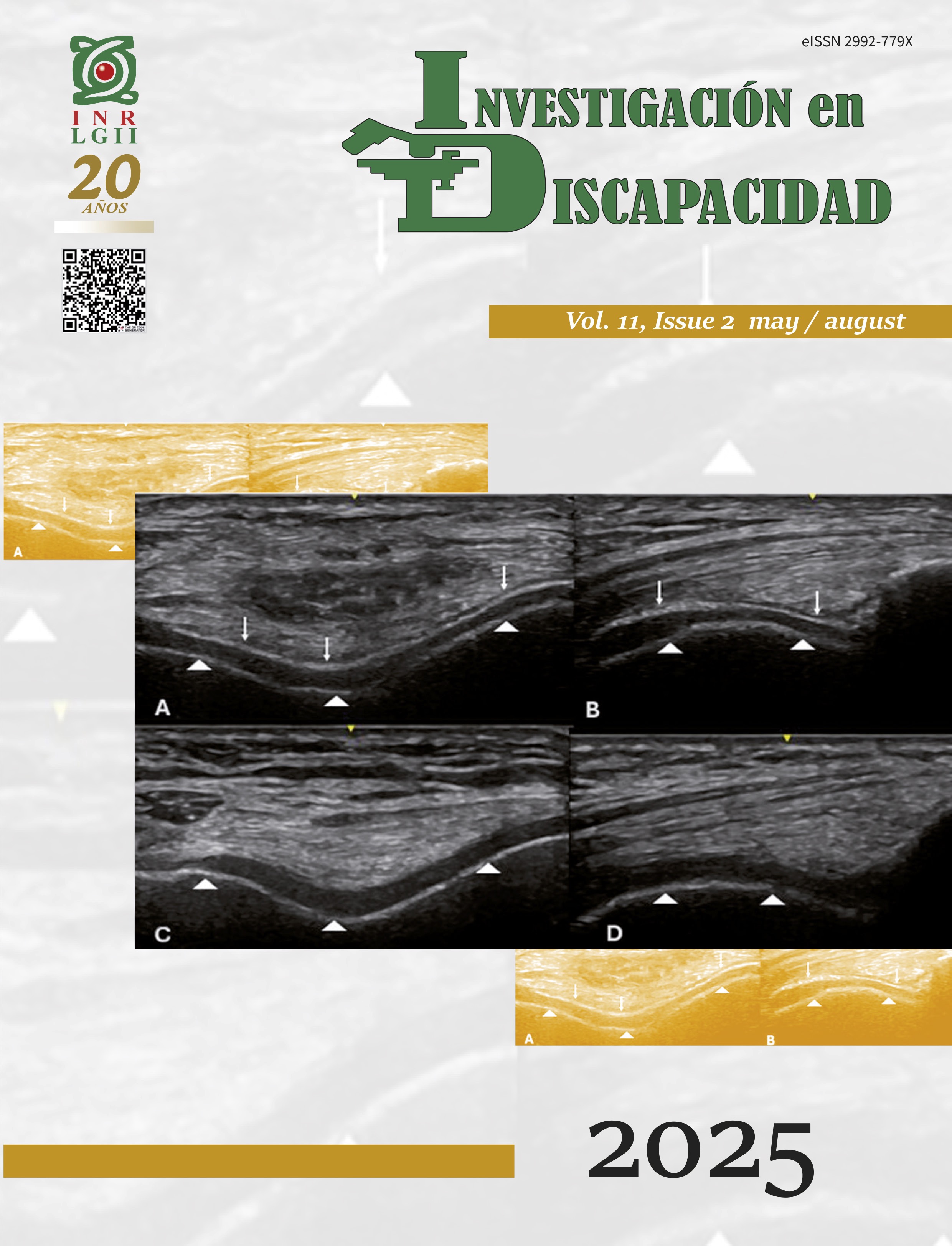TOR1A generalized dystonia: a pathology with phenotypic heterogeneity
DOI:
https://doi.org/10.35366/121458Keywords:
DYT-TOR1A, TOR1A, clinical heterogeneityAbstract
Introduction: Dystonia is a hyperkinetic movement disorder characterized by involuntary, sustained or intermittent muscle contractions, leading to repetitive movements and/or abnormal postures. Among genetic dystonias, the one associated with pathogenic variants of the TOR1A gene (DYT-TOR1A) is the most common, with an autosomal dominant inheritance model, and is related to the c.907_909delGAG variant. Its global prevalence is estimated to range from 7.6 to 16 cases per 100,000 individuals. Objective: The objective of this review was to describe the phenotypic heterogeneity of subjects with DYT-TOR1A from different populations over the past 5 years. Methodology: A bibliographic search was conducted in the PubMed and UW Libraries databases, following the PRISMA methodology. Inclusion and exclusion criteria were applied to select the most relevant articles. Results: A total of 131 articles were obtained (91 in PubMed and 46 in UW Libraries). After applying the selection filters, 124 publications were excluded, and 7 articles containing data from 36 subjects from eight countries were included in this systematic review: South Africa, Germany, Spain, Taiwan, South Korea, Japan, India, and Italy. Of these, 21 individuals showed clinical manifestations of dystonia (58.33%), and 15 family members were asymptomatic carriers (41.6%). Conclusions: DYT-TOR1A presents a challenge in clinical practice due to its heterogeneity in clinical manifestations. Future research is needed to elucidate the underlying mechanisms of the phenotypic variability, which is crucial for improving diagnosis and therapeutic options.
Publication Facts
Reviewer profiles N/A
Author statements
Indexed in
- Academic society
- N/A
References
Balint B, Bhatia KP. Dystonia: An update on phenomenology, classification, pathogenesis and treatment. Curr Opin Neurol. 2014;27(4):468-476. https://doi.org/10.1097/ WCO.0000000000000114
Balint B, Mencacci NE, Valente EM, et al. Dystonia. Nat Rev Dis Prim 2018;4:25. https://doi.org/10.1038/s41572-018-0023-6
Albanese A, Bhatia K, Bressman SB, et al. Phenomenology and classification of dystonia: a consensus update. Mov Disord. 2013;28(7):863-873. doi:10.1002/mds.25475
Hettich J, Ryan SD, de Souza ON, et al. Biochemical and cellular analysis of human variants of the DYT1 dystonia protein, TorsinA/TOR1A. Hum Mutat. 2014;35(9):1101-1113. doi:10.1002/humu.22602
Ozelius LJ, Hewett JW, Page CE, et al. The early-onset torsion dystonia gene (DYT1) encodes an ATP-binding protein. Nat Genet. 1997;17(1):40-48. doi:10.1038/ng0997-40
Weisheit CE, Pappas SS, Dauer WT. Inherited dystonias: clinical features and molecular pathways. Handb Clin Neurol. 2018;147:241-254. doi:10.1016/B978-0-444-63233-3.00016-6
Grundmann K, Laubis-Herrmann U, Bauer I, et al. Frequency and phenotypic variability of the GAG deletion of the DYT1 gene in an unselected group of patients with dystonia. Arch Neurol. 2003;60(9):1266-1270. doi:10.1001/archneur.60.9.1266
Ozelius, L., y Lubarr, N. DYT1 Early-Onset Isolated Dystonia. GeneReviews®. 1999.
Ozelius LJ, Bressman SB. Genetic and clinical features of primary torsion dystonia. Neurobiol Dis. 2011;42(2):127-135. doi:10.1016/j.nbd.2010.12.012
Moro E, LeReun C, Krauss JK, et al. Efficacy of pallidal stimulation in isolated dystonia: A systematic review and meta-analysis. Eur J Neurol 2017;24(4):552-560. https://doi. org/10.1111/ene.13255
Giri S, Biswas A, Das SK, Ray K, Ray J. Primary generalized dystonia due to TOR1A ΔGAG mutation in an Indian family with intrafamilial clinical heterogeneity. Neurol India. 2019;67(3):872-875. doi:10.4103/0028-3886.263172
Gambarin M, Valente EM, Liberini P, et al. Atypical phenotypes and clinical variability in a large Italian family with DYT1-primary torsion dystonia. Mov Disord. 2006;21(10):1782-1784. doi:10.1002/mds.21056
Van Coller R, Schutte C-M, Lübbe E, Ngele B. TOR1A mutation-related isolated childhood-onset generalised dystonia in South Africa. SAMJ, S. Afr. med. j. 2021 . https://doi.org/10.7196/samj.2021.v111i10.15801.
Wu MC, Chang YY, Chen YF, et al. Investigating DYT1 in a Taiwanese dystonia cohort. J Formos Med Assoc. 2022;121(1 Pt 2):375-380. doi:10.1016/j.jfma.2021.05.017
Hanaoka Y, Akiyama T, Yoshinaga H, et al. Monozygotic twins with DYT-TOR1A showing jerking movements and levodopa responsiveness. Brain Dev. 2021;43(7):783-788. doi:10.1016/j.braindev.2021.03.005
Li LX, Liu Y, Huang JH, et al. Genetic spectrum and clinical features in a cohort of Chinese patients with isolated dystonia. Clin Genet. 2023;103(4):459-465. doi:10.1111/cge.14298
Thomsen M, Marth K, Loens S, et al. Large-Scale Screening: Phenotypic and Mutational Spectrum in Isolated and Combined Dystonia Genes. Mov Disord. 2024;39(3):526-538. doi:10.1002/mds.29693
Opal P, Tintner R, Jankovic J, Leung J, Breakefield XO, Friedman J, et al. Intrafamilial phenotypic variability of the DYT1 dystonia from asymptomatic TOR1A gene carrier status to dystonic storm. Mov Disorder 2002;17(2):339–45.)
Bressman SB, Sabatti C, Raymond D, de Leon D, Klein C, Kramer PL, et al. The DYT1 phenotype and guidelines for diagnostic testing. Neurology 2000;54:1746e52.
Ozelius L, Lubarr N. DYT1 early-onset isolated dystonia. In: Adam MP, Ardinger HH, Pagon RA, Wallace SE, Bean LJH, Stephens K, et al., editors. GeneReviews((R)); 1993. Seattle (WA).
Elia, A. E., Filippini, G., Bentivoglio, A. R., Fasano, A., Ialongo, T., & Albanese, A. (2006). Onset and progression of primary torsion dystonia in sporadic and familial cases. European journal of neurology, 13(10), 1083–1088. https://doi.org/10.1111/j.1468-1331.2006.01387.x
Brüggemann N, Kühn A, Schneider SA, et al. Short- and long-term outcome of chronic pallidal neurostimulation in monogenic isolated dystonia. Neurology 2015;84(9):895-903. https://doi.org/10.1212/wnl.0000000000001312
Pauls KAM, Krauss JK, Kämpfer CE, et al. Causes of failure of pallidal deep brain stimulation in cases with pre-operative diagnosis of isolated dystonia. Park Relat Disord 2017;43:38-48. https://doi.org/10.1016/j.parkreldis.2017.06.023
Downloads
Published
How to Cite
Issue
Section
License
Copyright (c) 2025 Instituto Nacional de Rehabilitación Luis Guillermo Ibarra Ibarra

This work is licensed under a Creative Commons Attribution 4.0 International License.
© Instituto Nacional de Rehabilitación Luis Guillermo Ibarra Ibarra under a Creative Commons Attribution 4.0 International (CC BY 4.0) license which allows to reproduce and modify the content if appropiate recognition to the original source is given.




